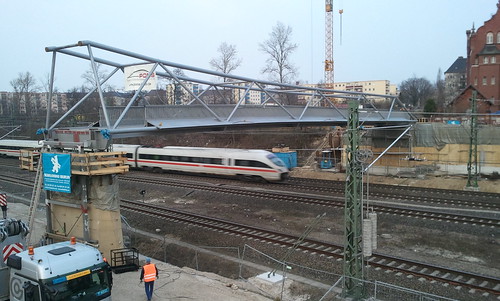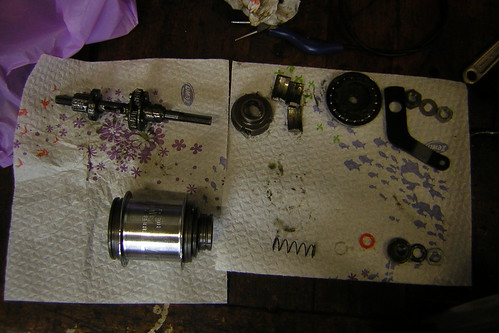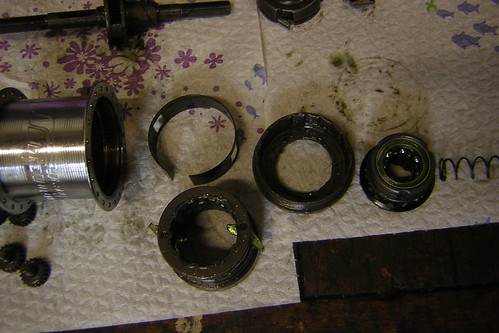Prima Parte – Una Delusione
If you look at the specs SRAM's i-motion 9 gear hub, they are really impressive. Unlike Shimano's proven excellent Inter-8 hub, the gears are spaced very evenly. Unlike previous SRAM hubs, the actuation doesn't sit vulnerably outside the bicycle's frame, but is inside like the Shimano's, but still much easier to take off when changing a tire. The hub got excellent reviews in magazines and blogs (like
this one on hubstripping), many bicycle makers embraced it, and the first bunch of buyers were happy. It looked like the German SRAM engineers of Schweinfurt had been able to offer a real alternative to Japanese bicycle parts domination.
However, if you look at the same product right now, there's some disappointment around. The hub really delivers on good gears and easy shifting, but reliability doesn't seem to be so good. Thinks break, hubs have to go to maintenance. Maybe the quality isn't even worse than previous SRAM hubs, like the Spectro S7, but the good performance of Shimano's products which are used in applications more demanding than what gear hubs previously experienced. Looking at the market right now, there are less manufacturers using this hub in their bikes. Biking through Berlin I see hundreds of bikes running Shimano gear hubs (especially the Inter-8 premium and Alfine 8), but I rarely see an i-motion 9 around.
I had decided to get an i-motion 9 for
Knicki, because I have the inter-8 on
Speedy and like to try something different. But everywhere I look for answers to some buying and fitting details, I find people telling me that I shouldn't get it and get Shimano instead. Of course, I don't know if the hub is really that bad. I requires much experience to make such a statement and I don't know who I can trust. Maybe, it's just bad marketing and bad crisis management at SRAM, while the product is not that bad. But frankly, for my bike I want something desirable and the i-motion isn't desireble to me any more.
Seconda Parte – Una Nicchia ben Riempita
sdfasdf While researching gear options for Knicki I also found Sturmey Archer's new X-RF8 hub. I could write a half-novel now about SA's history and how Sunrace of Taiwan saved this company with very long tradition (or at least some of their heritage). And I could as well talk about the strong parallels in SA's and F&S' history. Fichtel & Sachs (gear hub makers now part of SRAM) and Sturmey Archer both started producing three-speed hubs at the beginning of the 20th century and I am still not quite sure who of the two did actually invent the thing. But to cut a long story short, I want to talk directly about the very interesting business strategy of Sunrace in dealing with SA. The smart thing they did is not to face their competitors directly with similar products but fill market needs that are unsatisfied by the competition. Of course, a large part of their business is selling slightly improved versions of their traditional three-speed hubs to bicycle makers who have bought them for a long time and are still fitting them on (some of) their current models. But another part is the market for fun-bikes and fixes which they provided with a fixed-wheel gear-hub (that is, there is not free-wheel in any gear) and with a gear-hub that shifts by back-pedaling, thus without any cable or switch disturbing the clean looks of one of those “pure” single-speed bikes.
Another big market for SA is folding bikes. Many of their gear hubs are narrower than those of the competition. For example, the five-gear hub fits the Brompton frame without modification. (Even the 8-gear fits the Brompton, albeit with some widening of the frame.) SA also makes a hub which specifically combines with the Brompton's two-sprocket derailler to create a system of six evenly spaced gears. The principle is similar to SRAM Dual Drive and Shimano Intego, but the market is specialized and the product is the only one that not just dispenses with overlapping gears (dual drive 27-gear is just 13 or 15 “net” gears), but it also results in evenly spaced gears. It's been a close cooperation with Brompton Bicycles and it's called “Brompton Wide Gear” (BWR).
But it's SA's 8 gear hub, with the poetic name “X-RF8” (rear freewheel, as opposed to the RD8 with integrated drum brake) that I find particularly fascinating. It is not just constructed narrowly to fit smaller bikes. It also has the gear arrangement designed for smaller wheels. I find that particularly interesting, because I had previously wished that such a hub would exist. A bike with small wheels always needs a larger chain wheel or smaller sprockets to get the same development (distance traveled per crank-turn). The Shimano Inter-8 which I have in Speedy has its neutral gear (that is the gear in which the gear hub behaves like a non-gear hub) in position 5. I thought that if it was in position 4 instead, then the entire gear range would have a larger development and thus work with a larger sprocket than the current, tiny, and rare 14 teeth I am using now. And it is just this idea which engineers at Sunrace have take to their hearts and used to design into the hub. The result is a system where the smallest gear (first gear) is the neutral one and the other seven gears all are longer than neutral. This means that even with small wheels, a bicycle can use standard sizes for chain wheels and sprockets and yield a good development. Smaller chain wheels mean prettier bikes and more possibilities to mount chain guards. Larger sprockets mean less wear and tear. Sturmey Archer being the only company that's building such a hub means they'll have a lot of happy customers. That is, in theory at least. I find it disappointing that I don't know any folding bike manufacturer who's actually offering series models with the X-RF8. A quick googling only shows some custom-tuned Bromptons. Well, Sturmey, I wish you more success in the future with this great idea.
Terza Parte – Una Scommessa
Now that I am doubting to buy the i-motion 9 hub (and not wanting to buy something exotic as the X-RF8), I am almost back to square one again. For sure, I could just get another Shimano Inter-8, which would also be a different one than Speedy's because the product has since been upgraded with the “silent” roller clutches. But I really want to try something different and I especially want to try a hub with more evenly spaced gears so I can feel the difference to the Inter-8's very oddly spaced gears (14 to 22% for the different shifts).
So now, 2011, it's also the first season that Shimano's Alfine 11 is on the market. A device that on paper looks just as good as the i-motion 9 and better. And it comes from the market leader in sporty gear hubs. But does that mean it's gonna be really good? For one thing, it has its neutral gear in position 5 of 11 which means that it is also much easier to fit onto a twenty-incher (such as Knicki), which solves a problem that I had with the i-motion 9. On the other hand, I'd really like to build a wheel that's gonna last and create a bike that also has a good resale value when our relationship ends one day. I'd really like to wait just one more year to see how the new hub does in practice. But Knicki desperatly needs a revamp!
How will things work out for us? Read it on this blog. Sooner or later.
(PS: subscribe to the RSS to get notified of new posts.)



